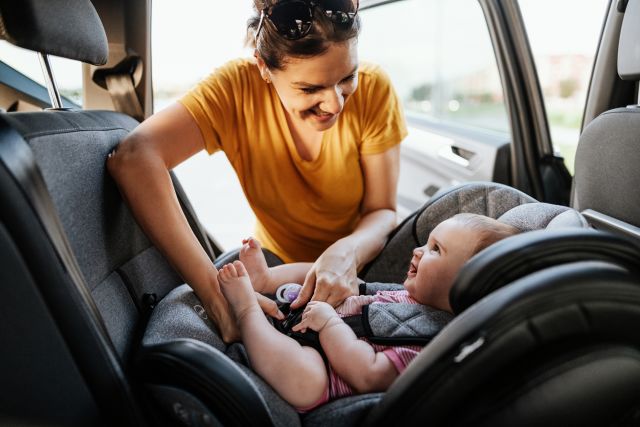Updated on June 13, 2022.
Every summer, it seems, news stories trend about children dying after being left in hot cars. Not only is the news upsetting but it would lead most parents to wonder: How could anyone forget their child in that way? Unfortunately, the death of a child due to vehicular heatstroke happens to even the most responsible caregivers and can even happen any time of the year.
According to noheatstroke.org, an initiative from the Department of Meteorology and Climate Science at San Jose State University, 910 children have died from vehicular heatstroke since 1998. In 2021, there were 23 deaths of children trapped in overheated cars. The children who have died in this way since 1998 range in age from 5 days to 14 years old, though more than half are under 2 years old.
At some point, every driver becomes distracted and stressed. Instead of thinking that this could never happen to you or your loved ones, it’s important to consider how children can be left in vehicles and understand the ways to prevent it.
How do kids get trapped in cars?
Over half of vehicular heatstroke cases recorded by noheatstroke.org occur when a parent or caregiver forgets that a child is in the car. These cases—which are labeled as unintentional—often happen when routines change, a driver is distracted, or a different caregiver is in charge of a drop-off. Once these drivers reach their destinations and park, they may leave their cars without realizing anyone is still in the vehicle.
There are other ways children can be unintentionally left in a car, as well. Approximately 1 in 4 vehicular heatstroke deaths in children occur when they gain access to a vehicle that’s been left unlocked. Kids might try to climb in to play or retrieve something, but may not be able to get themselves out of the car.
Finally, many parents and caregivers are simply misinformed about the danger of leaving a child in a vehicle. Cars can heat up very quickly, even when outside temperatures are in the high 50s or low 60s. A car’s internal temperature can increase by 20 degrees in just 10 minutes. Cracking windows or running the air conditioner while the engine is turned off in a parked vehicle is often not enough to cool it down.
Youngsters should never be left unattended, even for car trips that you think could take a minute. A short errand can always become delayed, causing a child to be unattended longer than anticipated.
How heat affects young kids
While extreme heat is dangerous for people of any age, younger children have a higher risk of heatstroke. A child’s body temperature can rise three to five times faster than an adult’s. They also don’t sweat at the same rate as adults, making them unable to cool their skin as rapidly. A child’s metabolism also functions more quickly than adults, producing more body heat.
When left in a hot car, it does not take long for a child’s body to reach extreme temperatures. Once a child’s internal temperature reaches 104 degrees Fahrenheit, organs begin to fail as they enter heatstroke. At 107 degrees, they could die within minutes.
If your child has been trapped in a hot vehicle, look for warning signs of heat illness, including the following:
- Red or hot skin
- Feeling faint or dizzy
- Nausea
- Vomiting
- Fever
- Heavy sweating
- Rapid pulse
- Headaches
- Confusion
- Muscle spasms and cramps
- Heat rash
If you observe any of these symptoms, call 911 or get your child to a hospital immediately.
Steps to prevent vehicular heatstroke
There are precautions any parent or caregiver can take to prevent a dangerous event.
Always lock your car when at home. And once you’re inside your home, keep your keys in a secure location that your child cannot reach. This prevents kids from finding their way into a parked car to play and accidentally trapping themselves inside. Let them know that cars should not be used for games.
Take your child out of the car at every stop. Even if you plan to dash in and out of a store, unbuckle your kid and bring them in with you. Even a minute in a car alone could be deadly.
Be alert when leaving your vehicle. End all phone conversations before you step out of your car. Make it a habit of looking into your windows instead of rushing off to work. The stress of starting the day can make us forgetful, so practice a routine that allows you to be mindful of your surroundings and responsibilities. The National Highway Traffic Safety Administration (NHTSA) advises training yourself to ask, “Where’s Baby?” or to “Park, Look, and Lock” each time you use a car.
Keep your belongings in the backseat. Whether it’s your bag, a cell phone, or even a shoe, keep an essential item that you wouldn’t leave without behind your seat. If your car has a remote start feature, consider putting the key in the backseat too. The NHTSA suggests placing a stuffed animal in the front seat when your child is in the back as a reminder to you.
Use technology and motion sensors. Some new car models and car seats come equipped with technology that alerts parents when a child is left in a vehicle. Other cars may have alarms that go off if any motion is detected around or inside the automobile. But remember: Technology is not foolproof, and a sleeping kid often won’t set off an alarm.
Have your daycare or caregiver call if your child is late or does not show up. This could indicate that your child is left in a perilous situation. If you are tasked with dropping off your child when it’s not normally part of your routine, have a partner, parent, or friend text you that morning to make sure everything went according to plan. If someone else is taking your kid to school, check in with them.
Finally, take action if you see a child in a car. Call 911 if you suspect a child may be in danger and wait until help arrives. Many people don’t want to meddle, but quick action could be the key to saving a child’s life.







